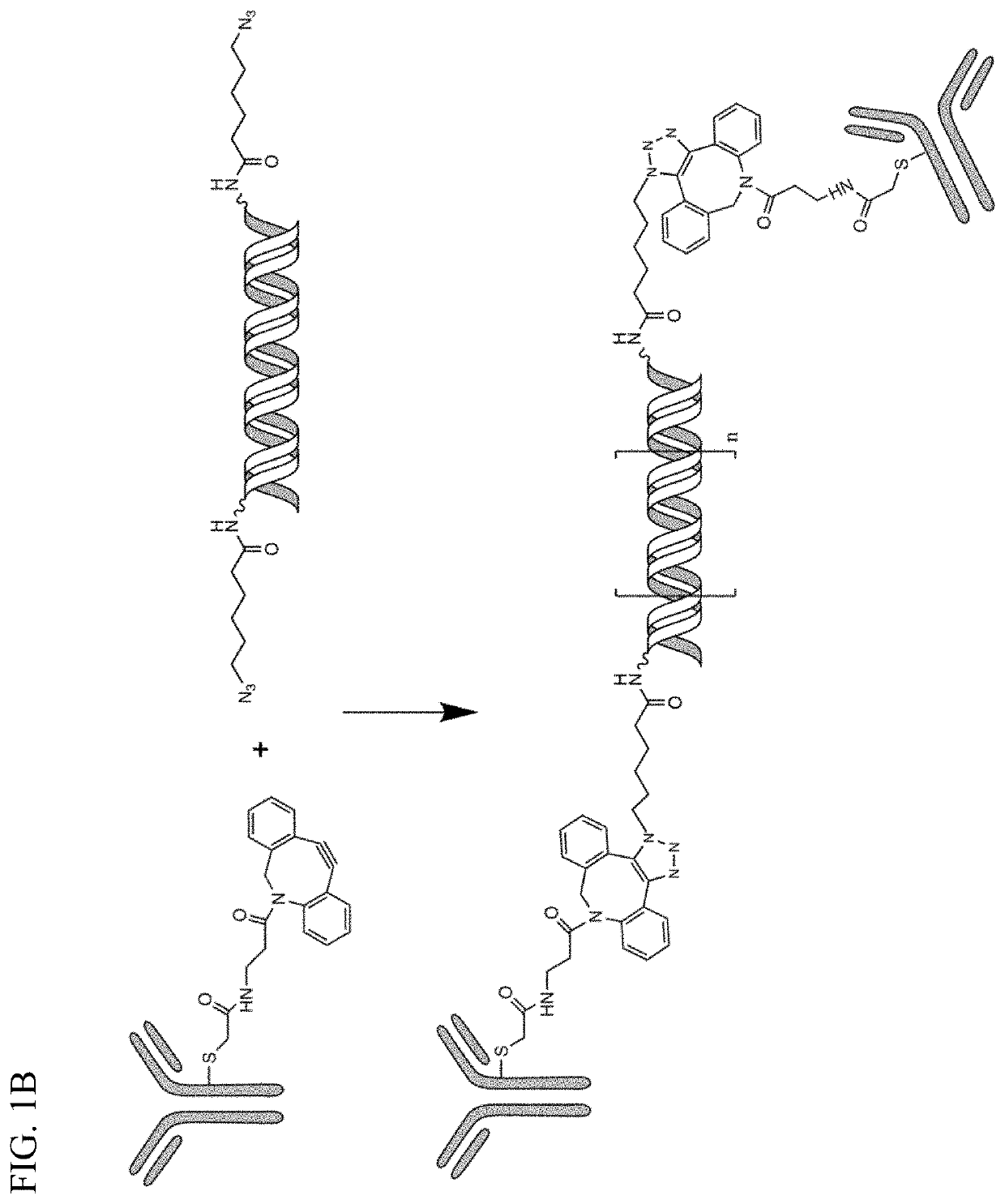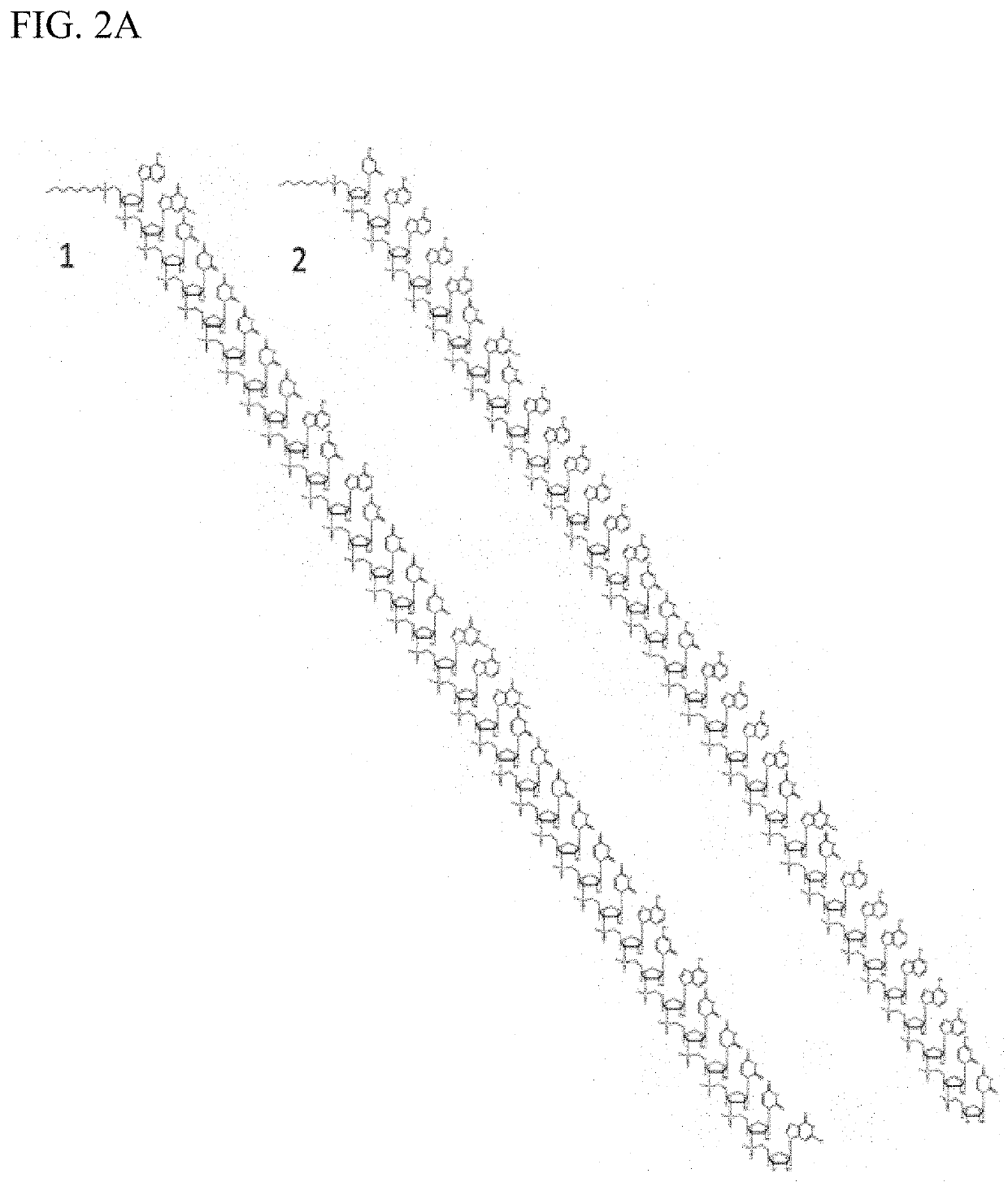Complementary RNA linked bispecific t-cell engaging antibodies
a t-cell engagement and antibody technology, applied in the field of complementary rna linked bispecific t-cell engagement antibodies, can solve the problems of inability to effectively bind target antigens, inefficient production methods, and inability to use multi-mer antibody conjugates and multi-specific antibodies, and prevent the ability of multi-specific antibodies to achieve the effect of binding
- Summary
- Abstract
- Description
- Claims
- Application Information
AI Technical Summary
Benefits of technology
Problems solved by technology
Method used
Image
Examples
example 1
duction and Characterization
[0285]Applicants attached complementary, protected RNA oligomers to the reduced hinge region of antibodies allowing for their self-hybridization / oligomerization either in solution or at the cell surface. This enhancement resulted in more efficient production of oligomeric bispecific antibodies with lower background than previous bispecific antibodies produced using click chemistry methods, whether in solution or at the cell surface. This method allows for the efficient production of multispecific antibodies, including mixing of reagents to create various cocktails of bispecific antibodies.
[0286]To produce the antibody conjugate, two antibodies were mildly reduced and derivatized with Br-DBCO. For example, antibody 1 was reacted by click chemistry with a first azido-oligo, while antibody 2 was reacted with a second azido-oligo that is complementary to the first oligo (FIG. 1A). After purification, the two antibodies were mixed and formed a tight cross-link...
example 2
igen Crosslinking
[0296]Applicants showed that BiTERs may be used to neutralize HIV. Although antibodies targeting glycoproteins may neutralize the virus, the antibodies function more effectively when they crosslink multiple glycoproteins. However, low spike density means that a single antibody cannot cross-link glycoproteins (FIG. 10). Thus, Applicants proceeded to generate an antibody conjugate including two identical antibodies that bind HIV surface glycoproteins attached with complementary 2′OMe RNA oligonucleotides (FIGS. 11 and 12).
[0297]The anti-gp120 antibody 3BNC was crosslinked to another 3BNC antibody using a dsRNA linker. The BiTER was shown to bind to cells expressing gp120, as analyzed by flow cytometry (FIG. 13). These results indicate that the dsRNA linked 3BNC antibodies may be used to crosslink multiple glycoproteins on the viral membrane, thereby effectively neutralizing the virus.
example 3
and Methods
[0298]The oligonucleotides were synthesized from the 3′-end to 5′-end, on 17.0 μmol scale, using standard phosphoramidite chemistry. Automated DNA / RNA Synthesizer OligoPilot10 plus from GE was used for the synthesis. The following phosphoramidites: 2′-OMe-Bz-A Phosphoramidite, 2′-OMe-C Phosphoramidite, 2′-OMe-G Phosphoramidite, 2′-OMe-U Phosphoramidite, were purchased from Thermo Fisher. Phthalamido Amino C6 lcaa CPG 1000 Å Support was purchased from Prime Synthesis.
[0299]Synthesis was performed using 3.5 eq of 2′-OMe phosphoramidite, and 8.5 min coupling time. The first added base was double coupled. Synthesis was completed in the DMT-ON mode. After that the coupling of 5′-Bromohexyl Phosphoramidite (Glen Research) was performed resulting in the attachment of Bromohexyl to the 5′-terminus of the oligo. Bromohexyl Phosphoramidite was double coupled with 2×3 eq for 2×5 min. Next step was the conversion of the bromide derivative into the azido derivative. We followed the pr...
PUM
| Property | Measurement | Unit |
|---|---|---|
| Fraction | aaaaa | aaaaa |
Abstract
Description
Claims
Application Information
 Login to View More
Login to View More - R&D
- Intellectual Property
- Life Sciences
- Materials
- Tech Scout
- Unparalleled Data Quality
- Higher Quality Content
- 60% Fewer Hallucinations
Browse by: Latest US Patents, China's latest patents, Technical Efficacy Thesaurus, Application Domain, Technology Topic, Popular Technical Reports.
© 2025 PatSnap. All rights reserved.Legal|Privacy policy|Modern Slavery Act Transparency Statement|Sitemap|About US| Contact US: help@patsnap.com



